
I’ve been shooting Henry Repeating Arms’ lever guns for decades. I always thought the Silver Series Henry was the all-American gunmaker’s best looking rifle. And it was — until I saw the new all-steel Color Case Hardened Edition in .45-70 Government. The gleaming black of the barrel, the dark brown of the walnut stock and the flowing clouds of dark color of the case hardened receiver combine perfectly.
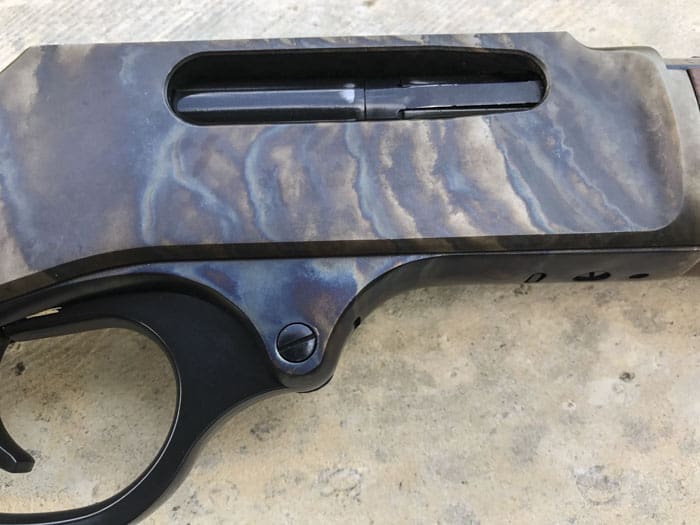
This rifle looks like it belongs in the woods. No, it looks like it belongs in the hands of a woodsman. It’s capable of taking any animal on earth, including elk or moose, at 100 yards. Its effectiveness comes from a time-tested design, great materials and quality craftsmanship. Its beauty is a side effect of a centuries-old technique: color case hardening.

In essence, case hardening is created by adding carbon to the outside of relatively soft iron and steel. It’s a manufacturing process that’s been used for hundreds of years to make a metal with a hard outside surface while maintaining a tough inner core.
It’s a simple process. But as someone who’s done it, the devil is very much in the details. Done well you get, well, you get what we have here. Henry’s taken a good-looking gun and dialed it up to 11.

While case hardening is beautiful, it’s not a finish. It still needs to be polished. Henry’s done just that on the Color Case Hardened Edition’s receiver and an outstanding job on the rest of the gun as well. The bluing and polishing is far better than I see on most production guns. Although not a true mirror finish, I can certainly see my reflection in the black-blued barrel.
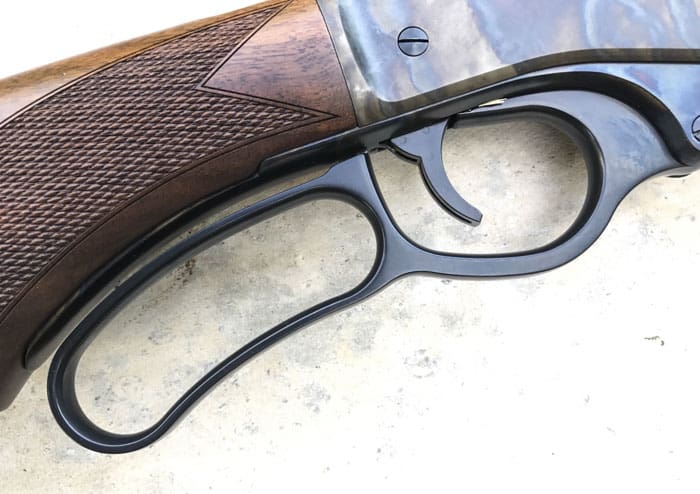
That level of shine carries on throughout the gun, including the lever itself.
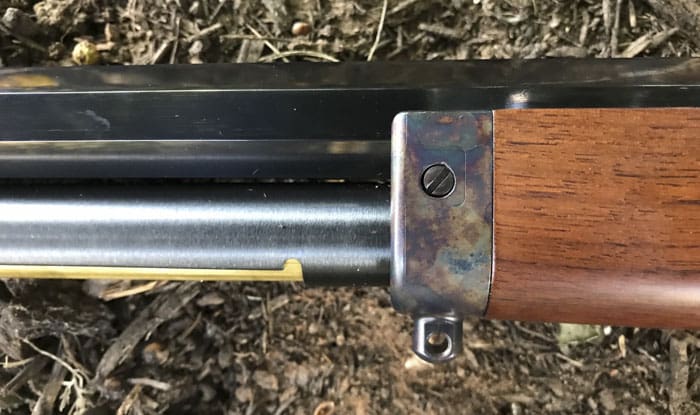
The rifle also sports little touches of style, easily overlooked, like the case hardened end cap. The walnut stock is of very good quality, straight grained and checkered. This particular example has no burl or quilt to it, but it really looks good next to the receiver and the black barrel.
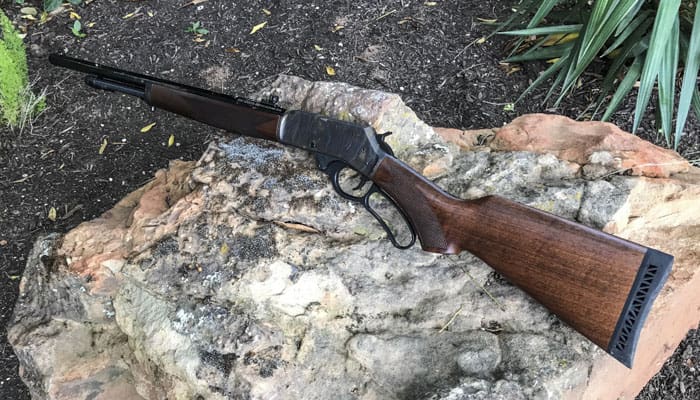
The Color Case Hardened Edition lever gun comes in two calibers: .30-30 and .45-70 Government. The .30-30 has a straight wrist stock while the .45-70 comes with a pistol grip style stock. Both are fashioned from American walnut with perfectly realized checkering for a positive grip. Weighing-in at just over eight pounds, with a shape that puts a large amount of the stock at the shoulder, recoil doesn’t feel particularly stout.

Well, not until you step up to the heaviest .45-70 loads. Then the thick rubber butt pad is a genuine blessing — although I dream of equipping the Color Case Hardened Edition rifle with a matching steel butt plate.
This Henry sports a 22-inch polished blued black octagonal barrel. Although I appreciate the ease of movement of a shorter barrel, I much prefer a 20-inch or longer barrel on a gun that will be shot with open sights, especially one chambered in .45-70. This is one of those rare instances where a few more inches really does mean something.
Specifically, roughly 20 FPS increased velocity per extra inch of barrel length. Do the math. The extra 100 FPS compared to a 16-inch guide gun yields just over an additional 100 ft/lbs of energy from 100-300 yards, as well as an extra inch of elevation and windage adjustment for each of those football fields.
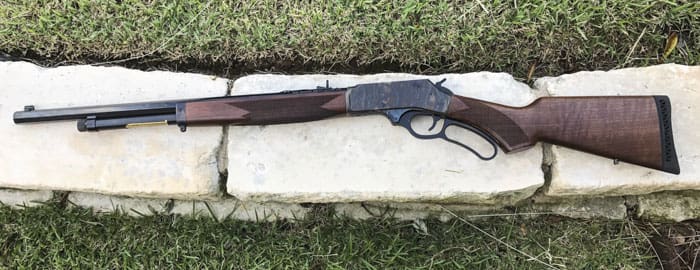
Of course, the real gain is the Color Case Hardened Edition’s longer sight radius. The longer the distance between those two sights gets, the more precise your aim becomes. I for one need every inch advantage I can get. Bonus! The 22″ barrel is also noticeably quieter than the 16″ and 18″ versions.
The Case Hardened Henry boasts the same dependable action as all other Henrys. This is an all American-made gun, born in Henry’s Rice Lake, Wisconsin factory. I’m not sure if it’s the factory, the model or the finish, but some Henry’s cycle better than others. While it’s rare for me to find one that doesn’t cycle well, some Henrys stand apart.

This is one of the better ones. There are no catches or stutters in the cycling process.
I’ve been shooting Marlins and my Winchester 94 a bit lately. I’d forgotten how nice it is not to have to intentionally squeeze the action at the top to make sure the action cycles fully. A quick tug down and the Color Case Hardened Edition’s action springs open. Any pull back sends the round into the chamber; the action almost closes all on its own. It really speeds up the shooting. With the .45-70, that means you have the joy of spending your ammo budget PDQ.
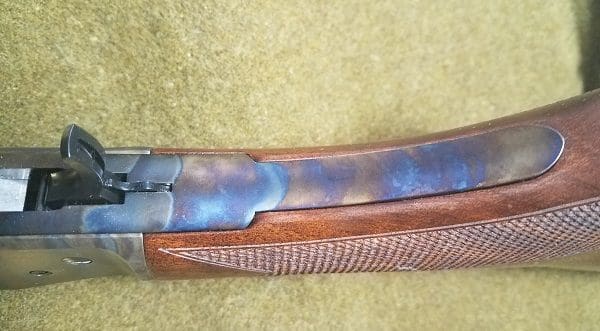
The Color Case Hardened Edition Henry is a hunting rifle — not just a brush, plains or blind rifle. There’s no cross bolt safety and no half cock. There doesn’t need for them. With the time-proven patented transfer bar, the big bore Henry will only fire if the hammer is fully cocked and someone pulls the trigger. You can safely carry the Color Case Hardened Edition on a loaded chamber with the hammer down while you stalk.

This rifle is topped by the same sights I’ve reviewed in several other Henrys. The All Steel models seem to come in two flavors: one with a wide front brass bead and one with a small front brass bead. This is the small bead, the one I prefer. Tucked into the semi-buckhorn ramp adjustable rear sight is a bright white diamond insert.
That insert sells these sights. There’s a teeny tiny notch right above it in the rear site; the brass front bead sits right inside it. Put the diamond insert under the bead and the bead under the target. When they all line up you’re ready to pull the trigger.
This set-up affords precise firing at long distances, and you can use the wider ears of the rear sight for fast shots up close, say on pigs running in the brush. The front sight shines up nicely with a bit of metal polish, and really pops out in any light.
My only disappointment with the Color Case Hardened Edition lever gun: the receiver’s interior isn’t polished smooth to match the exterior. In fact, the chattering tool marks on the interior of the receiver (where the bolt slides past) are large enough to catch on a dry cleaning patch.
I haven’t seen that on other Henry rifles, and it’s out of place here. It’s possible that the normal polishing done to the interior of the receiver after case hardening simply wasn’t aggressive enough for the [now] harder steel.

At just over five pounds, the Color Case Hardened Edition’s trigger pull is a little heavy. As with all the modern Henry rifle’s I’ve shot, trigger feel is excellent. If I pay close attention during slow fire, I can detect the slightest bit of creep just before the wall of tension and trigger break. But man, I have to really pay attention.
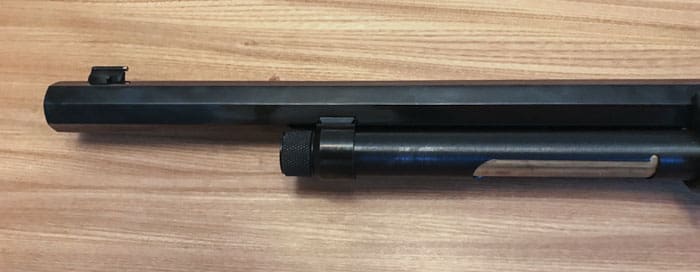
The website says the lever gun has a four-round tubular magazine. I had no problem loading five, as I have with other long-barreled Henrys. The tubular magazine system — basically a brass tube within a steel tube — is fragile. With the brass tube fully extended or removed, rough handling could bend or dent it. If you did so during a hunt you could still load the receiver directly. (I recommend buying a spare from the Henry website.)
A lot of gun buyers prefer a lever gun with a side loading gate. Not me. First and foremost, the tubular magazine is safer. The rifle doesn’t go in the hammer back “fire” mode over and over again as you cycle the action. And while it’s unlikely that your hand will slip and hit the trigger, with gloves on or cold hands, it could happen. With a side loading gate lever gun, the firearm would go bang.
Not so the Henry. Just leave the hammer down and dump the rounds. For an extra level of protection you can leave the action open while you do it.

On a rifle with a loading gate, if you load five rounds and don’t shoot them all – which is usually how it goes when you’re hunting – you end up ejecting rounds into the dirt, grass, mud or Saint Anthony help you, snow. With the tubular magazine, you pour out your unused round in one safe spot.
In an emergency — you’ve expended all your rounds and you still need to load another quickly — you simply open the action, insert a round into the breach and close the action– just like you would for a pump action shotgun.
Yes, your fingers are close to the muzzle when you load and unload. Leave the Color Case Hardened Edition’s hammer down when you do so. It isn’t going to magically cock itself, and that trigger doesn’t fire unless prodded. There’s a solid firing pin block; the weapon can’t go bang with the action open.
I put 160 rounds through this Color Case Hardened Edition, 60 of which were my own reloads. I shot my own Flat Tipped Round Nosed hand loads and various commercial loads from Hornady and Winchester. I cycled the rifle slowly and quickly. I shot it rapid fire for 40 rounds, as fast as I could load and fire, until the barrel was scalding hot to the touch. (Ask me how I know.) I had no issues with the rifle’s function in any situation with any ammunition.

The Hornady 325gr FTX LeveRevolution round was the top performing round. I shot an entire box, 20 rounds, in 4 five round groups for an average group size of 3″. We’re talking five round groups shot open sight off of a rest at 100 yards.
The mildest recoiling round, the Hornady 250gr Monoflex, scored slightly worse, at 3 3/4″. The round I can find anywhere in Texas — the Winchester 300gr JHP — split the difference between the two at 3 1/2″, although that was only for two 5 round groups. Several of my three-round groups would have hit the 1 1/2″ mark.
That group size has more to do with my old eyes than the rifle. As the Henry shoots that well with open sights at 100 yards I’d expect magnified optics to cut those groups in half. It’d be a shame to befoul the lines of this gorgeous gun with glass, but the terminal effect might be well worth it.
Fitted with even a low magnification scope the Color Case Hardened Edition is a 300-yard deer, antelope and pig killer. As is, right out of the box, it’s ready to take game out to 200-yards. And I do I mean right out of the box. The rifle was perfectly zeroed with the 300gr round from the moment I unwrapped it from the wax paper. I was shooting three to four inch circles around the bull’s-eye with no sight adjustment whatsoever.
Henry went back in time with the Color Case Hardened Edition lever gun. Looking forward, this gorgeous, accurate rifle made me glad that the Last Rifle I’ll Ever Need hasn’t been completed. I’m buying this Henry and doing all my hunting with it this fall and winter. That’s as strong an endorsement as I can make.

SPECIFICATIONS: Henry Color Case Hardened .45-70 Government
Action Type: Lever
Caliber: .45-70
Capacity: 4 Rounds (I was able to load 5 each time.)
Barrel Length: 22″
Twist Rate: 1:20
Overall Length: 40.4″
Weight: 8.10 lbs.
Receiver Finish: Colored Case Hardened Steel
Rear Sight: Fully Adj. Semi-Buckhorn w/ Diamond Insert
Front Sight: Brass Bead
Scopeability: Drilled and Tapped
Stock: Straight Grained American Walnut
Length Of Pull: 14″
Safety: Transfer Bar
MSRP: $995.00
RATINGS (out of five stars):
Style and Appearance * * * * *
I would normally take off at least half a star for less than stellar wood, but the gun’s overall fit and finish is excellent. The case hardening is perfectly achieved, protecting the five star rating.
Reliability * * * * *
Slow or fast, cold or blistering hot, the rifle cycled everything I put through it, and did it smoothly.
Customization * *
Sling it, or swap out the included swivel studs for a more traditional style. You can’t change much. Nor should you.
Accuracy * * * * 1/2
I can’t give it five stars because it didn’t break the 3-inch mark at 100 yards with open sights. But it did get right there. A pet load would almost certainly get below that 3-inch standard and any glass would cut those groups down significantly. With a scope, this is Thor’s Hammer to deer out to 300 yards. Without glass, I’d take a moose at 200 yards without concern.
Overall * * * * 1/2
Only one thing kept this gun from the five star mark: the unpolished interior receiver. Otherwise, the Color Case Hardened Edition Henry is absolutely gorgeous. Even better, that beauty is a lucky happenstance of a great performing rifle, capable of taking any animal that walks the Earth.




I had an opportunity to fire Henrys entry level .22 at the range last year. I was very impressed with the fit and finish but was amazed by the smooth operation and function of the rifle.
– And let it not be lost on any new readers here: that was Henry’s ENTRY LEVEL .22 he just mentioned…
There is a very good reason so many of us dream of owning one or several Henry rifles one day, and the prices for them are not outside the realm of making those dreams come true.
If it was offered in .308 I’d be driving home with one. It’s just plain gorgeous.
I don’t know what it is, but color hardening makes me a bit weak in the knees.
Jeremy S’s squeeze-cocker HK is drop-dead beautiful…
Anyone do a light steel-tubed case-hardened scope?
Case hardened/case colored,not to my knowledge however the best quality period scopes can be found at MVA.
http://montanavintagearms.com/
Can it be disassembled?
*Fully*?
.308? Loading a pointy-tipped spitzer bullet into a tube magazine is not something I would attempt. The reasoning should be obvious.
That’s why Hornady makes the LEVERevolution stuff I think.
https://www.hornady.com/ammunition/leverevolution#!/
Henry makes .308 lever guns – they just have detachable mags.
Outstanding USA Company…!!!
I have the Henry Long Ranger lever in .308.
Very Stylish, Cycles Smoothly
Shoots my reloads 1.5”
{Color case hardening}
“It’s a simple process. But as someone who’s done it, the devil is very much in the details.”
How about posting some pics of your efforts, sometime?
I have a hankering to give it a go sometime on a beater, and I’d appreciate a rundown on the basics from those who know, like yourself and Dyspeptic.
Make a good article all on it’s own…
The next time I’m doing a project that’s surface hardened I’ll do so, but just for an article, the juice is definitely not worth the squeeze. Right now I’m working through the considerations of case hardening a milled AK47 receiver. Remember, it’s not a finish, it changes the metal. So how the parts interact on each other is an important consideration.
Now that, I’d love to see.
It’s a simple process…..
until you deal with the potential warpage and through hardening.
Case hardening (of which color case hardening is a subset) requires the steel be brought above the critical temperature, and then left there, surrounded by either carbon monoxide, or cyanide, to react with the surface of the steel. The C or CN then react with the Fe on the surface (down to, oh, 0.025″ deep on a really deep casing job).
Then (for color casing) you take the object out of the furnace and slam it into a frothy water quench. This is where the warping can start.
Now, the steel you want to use for case hardening is something with a LOW carbon content, because you don’t want the object to harden “through” – ie, you just want a surface layer that is harder than Rc 50, you don’t want that as-quenched hardness all the way through the object, which is what will happen if you use 4140 or similar steels with a carbon content above, oh, 30 points.
8620 is the favored steel for making rifle receivers that are going to be color case hardened. The steel will remain soft below the case layer (Rc 35 to 40 or so), and the case layer (with the additional C/CN from the atmosphere will be up in the Rc 50+ range. A steel that is the equivalent of AISI 8620 was used to make the receivers on Garand rifles, and they’re case hardened in an atmosphere furnace – so there’s no color, but the outer layer is harder than a whore’s heart.
“It’s a simple process…..
until you deal with the potential warpage and through hardening.”
Well, that certainly makes jwt’s choice of a milled AK receiver as a project a wise choice…
🙂
That is one sweet looking rifle!
I’ve had lever fever for a while now and this has only exacerbated it!
It may be a dandy rifle however my issue with Henry and their products, goes back a bunch of years when they announced to SASS competitors that their pistol caliber rifles were SASS approved when they were not.
They finally were approved aprox five years latter by SASS but Henry was less than truth full to sell a product,that at the time couldn’t be used by competitors. To this day I forgo Henrys products because of their business decisions.
Great review – although the assertion that this (or any 45-70) can take any animal on earth might be a bit of an exaggeration. Any animal in North America might be more appropriate. Not sure I’d be completely comfortable going after Cape buffalo or (God forbid) elephant with this gun.
No sir, any animal on Earth, including the elephant and Cape Buffalo. Both have already been taken with the .45-70, and with a lever action rifle so chambered.
Word. .45-70 +P in Buffalo Bore 500 grain solids, Grizzly 405 grain Punch, and Underwood 305 grain Lehigh Extreme Penetrator all have a lot of penetration. The energy levels are right there with .450 / 400 3″ Nitro Express and 9.3 x 62.
I can understand Mr. Taylor being besotted with the new Henry rifle, but there is nothing on this Henry .45-70 that I did not find on my Pieta M1886 lever rifle (from Taylor’s). Color case hardened receiver? Check. Case hardened nosecap? Check. Case hardened hammer? Check. Case hardened buttplate? Check. Nice walnut stocks? Check. And I get a side loading gate and more magazine capacity. My Pieta ’86 cost more, so you win there, and I like the sights on the Henry better. Additionally, it took quite a bit of working the action to smooth it out, but that’s common with any Winchester-style lever gun. Overall, I’m pretty satisfied with my ’86s (have both a rifle and a carbine in .45-70 – considering selling the rifle due to the weight) because they are replicas of rifles used in the Old West, and not a modern interpretation of a Marlin side-ejector.
Are you sure that’s a Pietta and not a Chiappa or Pedersoli? I only ask because I couldn’t find a Pietta 1886 or a Pietta sold on Taylor’s Firearms website, but I could find the other two.
“…there is nothing on this Henry .45-70 that I did not find on my Pieta…”
did you find where it says “made in u.s.a.” on your chiappa?
No, but I’m not a purist when it comes to that. Even Winchester and Browning reintroductions of the 1886 and other old rifles from their lines were made overseas. Colt’s reintroduced cap-and-ball revolvers were made in Italy and finished in Hartford. All I care about is that the firearm looks exactly like the original weapon and works the same (no modern safeties or other doo-dads). Having said that, if a made-in-the-USA company could make a replica firearm for the same (or less) price-points and quality as the overseas replica, I’d buy it.
jwtaylor says:
September 25, 2017 at 11:04
“No sir, any animal on Earth, including the elephant and Cape Buffalo. Both have already been taken with the .45-70, and with a lever action rifle so chambered.”
JWTaylor
Along that line of thought.
FROM ELVES TO ELEPHANTS
http://www.leverguns.com/articles/paco/4570_leverguns.htm
You’re right – my bad. It’s a Chiappa. I’m at work so could not check. Nice catch.
You’ve got a really great rifle. Definitely one to be proud of.
Thanks! I enjoy shooting them. I love late 19th c. firearms, but can’t afford originals, hence replicas. I also have a replica Winchester 1876 carbine in .45-75 WCF that I am proud of and enjoy – very smooth and the recoil doesn’t beat me to death, and a Pedersoli Winchester 1892 carbine in .45 Colt – very slick action and good on deer out to 150 yds or so! I hope you enjoy your new Henry .45-70 – looks like quite the rifle!
I don’t own one but a Henry has been on my wish list as long as I can remember. Something else always seems to come along and keep it out of the top spot. Beautifully made in the USA, outstanding fit and finish, glass smooth action and very reasonably priced for their level of quality.
Henry and Henry owners keep telling me I don’t need a side loading gate or a safety. You know what? I still want a side loading gate and a safety. I’m not a fan of flimsy brass tubes. By the way, my Marlin 1895 XLR has both of those features, can put 3 rounds of LeverEvolution into 1.5″ at 100 yards, and looks pretty good in stainless/ laminate.
It doesn’t look as good as this gun, though.
I’d love to have one. But here in commie kalifornia, likely an ASSAULT RIFLE and to dangerous for mere citizens to own. Of course, Law Enforcement is exempt.
Nope. Perfectly legal here. All “assault weapons” are semi-auto centerfire. The only issues I’ve seen mention of are where some of the tubes on lever guns hold more than ten rounds. I’ve seen a post suggesting that the reproduction Colt Lightning may be one of them, but I haven’t looked into it.
Wow.
Serious want factor!
I think this rifle’s receiver was dropped into the quench front-end first, and that’s how they got that “wavy” appearance to the casing on both sides.
.45-70 Government holds no allure for me, but .30 WCF is a whole different kettle of fish. I’ll probably end up buying another old Winchester M94 because I’m not a fan of Henry-style tube loading and old (quality) Marlins are getting very rare and hard to find.
But dayum, that Henry is purdy.
Hmm. Not a fan of the Henry loading system, and for .45-70, a 24″ barrel would be better. But I have to agree that this is a very nice looking rifle. then again, I am not a fan of the modern Winchester rebounding hammer and tang mounted safety either, but they are safe to unload. The safety in particular irks me because that is exactly where you would mount long range vernier sights.
Oooh, purty, want.
I think you will find these rifles are case colored, not color case hardened. It looks to be a chemically dipped finish. The writer is mistaken, or he was given bad information.
No sir. According to the Henry website “the colors come from a genuine case-hardening process…”
Torn between this and the all weather series… I will have me a Henry in 45-70 soon… and may have to get me another 30-30… Love my Winchester 94… but I also love a Henry. I feel like going home and shooting my Henry 22…
JWT – From the day late, dollar short dept., Based on what Dyspeptic mentioned, a metallurgical assay on the potential receiver may be a wise investment beforehand. DG can probably point you in the direction of a lab that understands firearm metals when running that percent-carbon test.
A monolithic ‘chip’ of the metal would be better than grindings or shavings , as they will likely be contaminated with bits of the tooling used to remove them that may well be a type of “high-carbon tool steel” themselves.
You want as a contaminated-free sample as possible…
Thanks, I am not unfamiliar with the process. I worked at a foundry in my younger life.
I own this rifle and a Big Boy in .44 magnum. They are both works of art. The .45-70 makes me laugh every time I pull the trigger. The report and the recoil making firing this rifle quite fun.
“Every man needs a big bore rifle.” That’s the quote that pointed me at this rifle.
Thanks for the great review. I do have one question.
Does the color case hardened finish differ in durability from either the brass on the H010B or the blued steel on the regular H010? How do the finishes compare as far as maintenance, durability, oxidation, etc.
I am really wanting to pick one of these up and I am trying to decide on my finishes. Like the look of the brass, but seems too pretty and has no rubber recoil pad (not a deal breaker). I like the CCH finish too, and it comes with the pistol stock grip which I prefer over the straight.
Thanks
I purchased this Henry rifle for my husband for Christmas. I hope he likes it, I let the owner of the gun store pick it out. All I knew to ask for was a 45-70 Henry Rifle. He showed me three, this one was not the most expensive or least expensive, but absolutely the most stunning out of the three. Love the hard color coated finish.
Just curious as to what you mean by saying that a side loading rifle needs the hammer to go into the firing position over and over? And therefore the tube is safer?
Side loading DOSE NOT require manipulation of the lever to load the firearm.
Gear up as your favorite Delsin Rowe Vest. Slim Fit Leather Jackets brings this iconic jacket from animation to reality, especially for all the fans of this video game. Delsin Rowe is the main protagonist and playable character, a young Native-American man who later realizes he’s a Conduit with special powers.